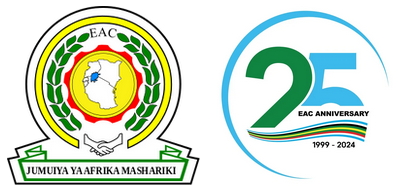
EAC trade soars to USD 38.2 billion in Q2 2025 as exports surge 40%
East African Community Headquarters, Arusha, Tanzania, 10th November, 2025: The East African Community (EAC) recorded a strong upswing in international merchandise trade during the second quarter of 2025, underscoring the region’s resilience and growing competitiveness in global markets. According to the latest EAC Quarterly Statistics Bulletin, total trade rose by 28.4% to USD 38.2 billion, up from USD 29.7 billion in the same quarter of 2024.
This performance was driven largely by exports, which surged by 40.5% to USD 18.6 billion, reflecting rising global demand for EAC products. Imports grew more moderately by 18.8% to USD 19.6 billion. As a result, the trade deficit narrowed significantly from USD 3.2 billion to USD 0.9 billion, marking a notable improvement in the external trade balance.
Trade with other African countries expanded by 42.9% to USD 9.3 billion, now accounting for 24.5% of total trade. Intra-EAC trade grew by 24.5% to USD 4.6 billion, representing 12.1% of total trade. The EAC also deepened its commercial links with COMESA and SADC, which contributed 9.9% and 15.2%, respectively, to the region’s trade portfolio.
Exports were maintained by strong demand from China, the United Arab Emirates, South Africa, Hong Kong, and Singapore, which together absorbed 62.8% of total exports, up from 40.1% a year earlier. Malaysia and South Africa registered the highest quarter-on-quarter growth. The top five export commodities: copper, precious stones and metals, coffee and tea, mineral fuels, and ores, which accounted for 79.6% of total exports, compared to 77.2% in Q2 2024, highlighting the region’s growing specialisation in high-value goods.
China remained the leading source of imports, contributing USD 4.7 billion or 24.2% of the total. The UAE, India, South Africa, and Japan also maintained strong positions, jointly accounting for more than half of the import bill. Key imported commodities included petroleum products (USD 4.1 billion), machinery (USD 1.8 billion), vehicles (USD 1.5 billion), precious metals (USD 1.5 billion), plastics, and iron and steel products, reflecting continued investment in infrastructure, industry, and energy.
Overall, the EAC’s trade performance in Q2 2025 signals a dynamic and diversified regional economy. The narrowing trade deficit, rising exports, and expanding intra-African trade point to a positive trajectory for integration and sustainable growth.
The EAC Secretariat remains committed to fostering a conducive environment for trade and investment, enhancing value addition, and promoting shared prosperity across Partner States.
Inflationary Pressures
The bulletin indicates that inflation in the region remains a concern. The Annual Headline (Year-on-year) Inflation in the EAC region as measured by the EAC Harmonised Consumer Price Index (EAC-HCPI) stood at 22.7% in June 2025 from 24.0% registered in May 2025. A year earlier (June 2024), the rate was 13.7%
“The annual average headline inflation for the 2024/25 financial year stood at 23.0% up from 6.6% which was recorded for the 2023/24 financial year,” reveals the quarterly bulletin. This increase was due to increases that were registered for the Republics of South Sudan and Burundi which stood at 179.4% and 34.1% respectively.
The Core inflation, which excludes food and energy prices, stood at stood at 19.3% in June 2025, down from 23.6% registered in May 2025. A year earlier, the rate was 15.0% in June 2024.
Monetary Developments and Credit Growth
On monetary conditions, the Bulletin notes that short-term interest rates increased across most EAC Partner States in quarter two (Q2) 2025, except in Kenya, where the 91-day Treasury bill rate declined by 70 basis points to 8.2%. Uganda and Burundi recorded the highest Treasury bill rates at 11.2 and 8.6%, respectively.
The bulletin shows that the the lending rate declined for both Kenya and Tanzania while Uganda recorded the highest increase of 140 basis points. Deposit rates declined or remained stable for majority of Partner States except for Tanzania who recorded an increase of 70 basis points. South Sudan registered the widest interest rate spread (13.7%), whereas Tanzania recorded the narrowest (6.5%).
“The EAC money supply (M3) grew by 19.1% year-on-year in Q2 2025 which was driven mainly by a 19.2% rise in credit to the private sector reflecting continued monetary expansion across the region,” reveals the bulletin.
About the Bulletin
The EAC Quarterly Statistics Bulletin is compiled by the EAC Secretariat in collaboration with National Statistics Offices and Central Banks of the Partner States. It provides harmonised data on inflation, trade, money supply and other key macroeconomic indicators to inform policy and planning.
The full Q2 2025 Bulletin is available at: https://eac.opendataforafrica.org/ihrbbkg/statistics-bulletin
For more information, please contact:
Corporate Communications and Public Affairs Department
EAC Secretariat
Arusha, Tanzania
This email address is being protected from spambots. You need JavaScript enabled to view it. / This email address is being protected from spambots. You need JavaScript enabled to view it.
http://www.eac.int
About the East African Community Secretariat:
The East African Community (EAC) is a regional intergovernmental organisation of eight (8) Partner States, comprising the Republic of Burundi, the Democratic Republic of Congo, the Republic of Kenya, the Republic of Rwanda, the Federal Republic of Somalia, the Republic of South Sudan, the Republic of Uganda and the United Republic of Tanzania, with its headquarters in Arusha, Tanzania. The Federal Republic of Somalia was admitted into the EAC bloc by the Summit of EAC Heads of State on 24th November, 2023 and became a full member on 4th March, 2024.
